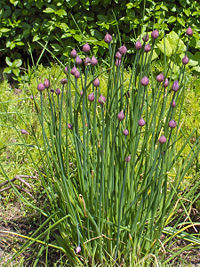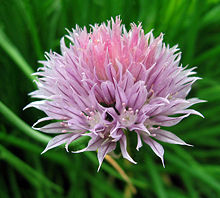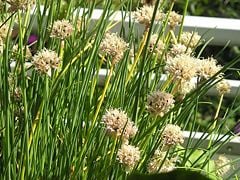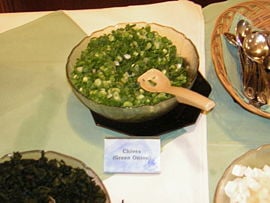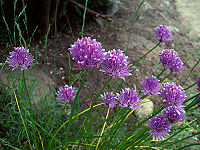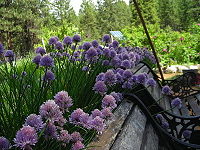Chives
| Chives | ||||||||||||||||||
|---|---|---|---|---|---|---|---|---|---|---|---|---|---|---|---|---|---|---|
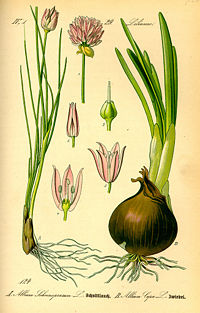 | ||||||||||||||||||
| Scientific classification | ||||||||||||||||||
| ||||||||||||||||||
| Allium schoenoprasum L. |
Chive, generally used in the plural as chives, is the common name for a bulbous, fragrant, herbaceous plant, Allium schoenoprasum, which is characterized by slender, hollow leaves and clusters of lavender flowers. The term chives also refers more specifically to the edible leaves of this plant, which are used as a popular seasoning. Because the plants grows in clumps, rather than as individual plants, typically the term chives is used rather than chive, although various references also use chive as the main entry.
Chives are used as common culinary herbs to provide a mild onion flavor, with the leaves used fresh or dried. The colorful and edible flowers also may be added for salads. In addition, chives are cultivated for their ornamental value, such as used in dry bouquets or in flower gardens, and traditionall have been used for medicinal value.
Description
Chive is the smallest species of the onion family Alliaceae (LaFray 1987). Alliaceae is a taxa of herbaceous perennial flowering plants. They are monocots and part of order Asparagales. The family has been widely but not universally recognized; in the past, the plants involved, including chives, were often treated as belonging to the family Liliaceae, and still are by some botanists.
The chive is a bulb-forming herbaceous perennial plant, growing to 30-50 cm tall. The bulbs are slender conical, 2-3 cm long and 1 cm broad, and grow in dense clusters from the roots. The leaves are hollow tubular, up to 50 cm long, and 2-3 mm in diameter, with a soft texture, although, prior to the emergence of a flower from a leaf, it may appear stiffer than usual. The flowers are pale purple, star-shaped with six tepals, 1-2 cm wide, and produced in a dense inflorescence of 10-30 together; before opening, the inflorescence is surrounded by a papery bract. The seeds are produced in a small three-valved capsule, maturing in summer. The herb flowers from April to May in the southern parts of its habitat zones and in June in the northern parts.[1][2]
Chives are the only species of Allium native to both the Old World and New. Sometimes, the plants found in North America are classified as A. schoenoprasum var. sibiricum, although this is disputed. There have been significant differences among specimens: one example was found in northern Maine growing solitary, instead of in clumps, also exhibiting dingy gray flowers.[3]
Its species name derives from the Greek skhoinos (sedge) and prason (onion).[4] Its English name, chive, derives from the French word cive, which was derived from cepa, the Latin word for onion.[5]
Cultivation
Chives have been cultivated in Europe since the Middle Ages, although signs of its usage date back to 5000 years ago[5].
Chives thrive in well drained soil, rich in organic matter, with a pH of 6-7 and full sun.[6]
Chives can be grown from seed and mature in summer, or early the following spring. Typically, chives need to be germinated at a temperature of 15 °C to 20 °C and kept moist. They can also be planted under a cloche or germinated indoors in cooler climates, then planted out later. After at least four weeks, the young shoots should be ready to be planted out.
In the winter, chives die back to the underground bulbs, with the new leaves appearing in early spring. Chives starting to look old can be cut back to about 2-5 cm; this length is also preferred when harvesting, making the unattractive yellowing appear close to the ground, so that the plant can retain its aesthetic value.
Uses
Culinary
Template:Limitedgeographicscope
Chives are grown for their leaves, which are used for culinary purposes as condiment, which provide a somewhat milder flavour than its neighbouring Allium species.
Culinary uses for chives involve shredding its leaves (straws) for use as condiment for fish, potatoes and soups. Because of this, it is a common household herb, frequent in gardens as well as in grocery stores. Chives have a wide variety of culinary uses, such as in traditional dishes in France[7] and Sweden[8], among others. In his 1806 book Attempt at a Flora (Försök til en flora), Retzius describes how chives are used with pancakes, soups, fish and sandwiches.[8] It is also an ingredient of the gräddfil sauce served with the traditional herring dish served at Swedish midsummer celebrations. The flowers may also be used to garnish dishes. [9]
Chives are one of the "fines herbes" of French cuisine, which also include tarragon, chervil and/or parsley.
Chives can be found fresh at most markets year-round, making it a readily available spice herb; it can also be dry-frozen without much impairment to its taste, giving home growers the opportunity to store large quantities harvested from their own garden.[5]
Gardening and ornamental
Retzius also describes how farmers would plant chives between the rocks making up the borders of their flowerbeds, to keep the plants free from pests (such as Japanese beetles[10]).[8]. While the growing plant repels unwanted insect life, the juice of the leaves can be used for the same purpose, as well as fighting fungal infections, mildew and scab. [11][12][13]
It also has insect-repelling properties which can be used in gardens to control pests.[14]
Its flowers are attractive to bees, which are important for gardens with an abundance of plants in need of pollination.
Albeit repulsive to insects in general, due to its sulfur compounds, its flowers are attractive to bees, and it is sometimes kept to increase desired insect life.[15]
Medical uses
The Romans believed chives could relieve the pain from sunburn or a sore throat. They believed that eating chives would increase blood pressure and acted as a diuretic.[citation needed]. It was believed that bunches of dried chives hung around a house would ward off disease and evil.[16]
The medical properties of chives are similar to those of garlic, but weaker; the faint effects in comparison with garlic are probably the main reason for its limited use as a medicinal herb. Containing numerous organisulplide compounds such as allyl sulfides[17] and alkyl sulfoxides, chives have a beneficial effect on the circulatory system, acting upon it by lowering the blood pressure.[18] As chives are usually served in small amounts and never as the main dish, negative effects are rarely encountered, although digestive problems may occur following over-consumption.[18]
Chives are also rich in vitamins A and C, and contain trace amounts of sulfur and iron.[16]
ReferencesISBN links support NWE through referral fees
name="mobot">Allium schoenoprasum factsheet, from Kemper center for home gardening, Missouri Botanical Garden, 2001-2008 retrieved on June 13, 2006</ref>. T
External links
All links retrieved December 13, 2007
- Nutritional Information
- Mrs. Grieve's "A Modern Herbal" @ Botanical.com
- Chives, history, clutivation, container growing and a recipe
| Herbs and spices | |
|---|---|
| Herbs | Angelica • Basil • Basil, holy • Basil, Thai • Bay leaf • Boldo • Borage • Cannabis • Chervil • Chives • Coriander leaf (cilantro) • Curry leaf • Dill • Epazote • Eryngium foetidum (long coriander) • Hoja santa • Houttuynia cordata (giấp cá) • Hyssop • Lavender • Lemon balm • Lemon grass • Lemon verbena • Limnophila aromatica (rice paddy herb) • Lovage • Marjoram • Mint • Mitsuba • Oregano • Parsley • Perilla (shiso) • Rosemary • Rue • Sage • Savory • Sorrel • Stevia • Tarragon • Thyme • Vietnamese coriander (rau răm) • Woodruff |
| Spices | African pepper • Ajwain (bishop's weed) • Aleppo pepper • Allspice • Amchur (mango powder) • Anise • Aromatic ginger • Asafoetida • Camphor • Caraway • Cardamom • Cardamom, black • Cassia • Cayenne pepper • Celery seed • Chili • Cinnamon • Clove • Coriander seed • Cubeb • Cumin • Cumin, black • Dill seed • Fennel • Fenugreek • Fingerroot (krachai) • Galangal, greater • Galangal, lesser • Garlic • Ginger • Grains of Paradise • Horseradish • Juniper berry • Liquorice • Mace • Mahlab • Malabathrum (tejpat) • Mustard, black • Mustard, brown • Mustard, white • Nasturtium • Nigella (kalonji) • Nutmeg • Paprika • Pepper, black • Pepper, green • Pepper, long • Pepper, pink, Brazilian • Pepper, pink, Peruvian • Pepper, white • Pomegranate seed (anardana) • Poppy seed • Saffron • Sarsaparilla • Sassafras • Sesame • Sichuan pepper (huājiāo, sansho) • Star anise • Sumac • Tasmanian pepper • Tamarind • Turmeric • Wasabi • Zedoary |
Credits
New World Encyclopedia writers and editors rewrote and completed the Wikipedia article in accordance with New World Encyclopedia standards. This article abides by terms of the Creative Commons CC-by-sa 3.0 License (CC-by-sa), which may be used and disseminated with proper attribution. Credit is due under the terms of this license that can reference both the New World Encyclopedia contributors and the selfless volunteer contributors of the Wikimedia Foundation. To cite this article click here for a list of acceptable citing formats.The history of earlier contributions by wikipedians is accessible to researchers here:
The history of this article since it was imported to New World Encyclopedia:
Note: Some restrictions may apply to use of individual images which are separately licensed.
- ↑ Allium schoenoprasum factsheet, from Kemper center for home gardening, retrieved on June 13, 2006, based on the position of the botanical Garden (Missouri)
- ↑ Gräslök, from Den virtuella floran, retrieved on June 13, 2006, The facts mentioned on the site apply to Sweden, which is in the northern part of the habitat zone.
- ↑ McGary, Mary Jane (2001). Bulbs of North America: North American Rock Garden Society. Portland: Timber Press, 28-29. 088192511X.
- ↑ Gräslök, from Den virtuella floran, retrieved on June 13, 2006
- ↑ 5.0 5.1 5.2 Chives, from homecooking.about.com, accessed on June 13, 2006
- ↑ Allium schoenoprasum factsheet, from Kemper center for home gardening, retrieved on June 13, 2006
- ↑ Chives
- ↑ 8.0 8.1 8.2 Försök til en Flora Oeconomica Sveciæ by A. J. Retzius (1806)
- ↑ Allium schoenoprasum, from Mountain valley growers, accessed on June 13, 2006
- ↑ pests - selfsufficientish - pests
- ↑ Holtom. J. and Hylton. W. Complete Guide to Herbs. Rodale Press 1979 ISBN 0-87857-262-7
- ↑ Riotte. L. Companion Planting for Successful Gardening. Garden Way, Vermont, USA. 1978 ISBN 0-88266-064-0
- ↑ Huxley. A. The New RHS Dictionary of Gardening. 1992. MacMillan Press 1992 ISBN 0-333-47494-5
- ↑ Kaufman, Peter B and Thomas J Carlson, Kaufman B Kaufman, Harry L Brielmann, Sara Warber, Leland J Cseke, James A Duke (1999). Natural Products from Plants. Boca Raton: CRC Press, 261. 084933134X.
- ↑ Baines. C. Making a Wildlife Garden. 0
- ↑ 16.0 16.1 Chives, from "Sally's place", accessed on June 13, 2006
- ↑ Burdock, George A (1996). Encyclopedia of Food & Color Additives. Boca Raton: CRC Press, 87, 95-96. 0849394120.
- ↑ 18.0 18.1 Talkin' Chive, by Winston J. Craig, Ph. D, from Vibrantlife.com, accessed on June 13, 2006
- ↑ LaFray, Joyce (1987). Tropic Cooking: The New Cuisine from Florida and the Islands of the Caribbean. Oakland: Ten Speed Press, 292. 0898152348.
